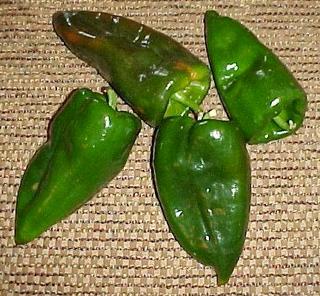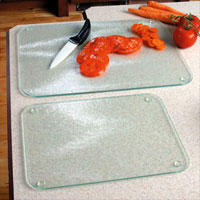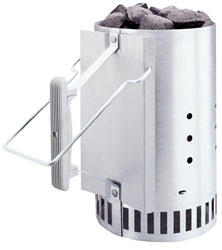Thursday, August 18, 2005
UglyRipe Update
It looks like the Senate is about to get involved in the UglyRipe tomato fight . . .
Red Delicious RIP?
Probably too early to celebrate, but the future doesn't look bright for the bland Red Delicious apple. Thanks to Too Many Chefs for the link.
Beer-Battered Chicken Chile Rellenos

I found some great poblano chiles at the Marion Square market over the weekend, and this is the dish I concocted to use them. I happened to have some leftover barbecued chicken (hickory smoked on the grill the night before) and corn, so that's what I used for the filling. But, you could substitute all kinds of ingredients and make an equally great meal. Here's my version, which used four poblanos (enough to serve two people):
First, make the batter, since it needs to chill in the refrigerator for 30 minutes or so before using. Mix 3/4 cup flour with 1/2 tsp baking powder and a pinch of salt, then pour in half a bottle of beer (the rest is for the chef) and stir until smooth. Refrigerate the batter while you do the rest.
The next step is to roast and peel the four poblano peppers. There are many ways to do this, but since I don't (alas) have a gas stove I use my oven's broiler. Place the peppers on a sheet of aluminum foil and put under the broiler. Broil them for a minute or two on each side until the skin is blistered, turning the peppers with tongs until they are roasted all over. Don't worry if the skin turns black in some places, as long as the pepper doesn't get totally charred. (Other ways to accomplish the blistering is to toast them marshmallow-style over a gas burner, toss them in a hot cast iron skillet, or roast them in a 375-degree oven.)
Once the skins are blackened and bubbly, wrap in damp paper towels and put in a plastic baggie (or, in a bowl covered with plastic wrap), and leave them there for 10 minutes or so. This steaming will make the skin easier to remove.
While the peppers are resting, mix up the filling. To follow my version, dice up a smoked chicken breast and mix it with about a 1/2 cup of corn kernels, 4 oz. of white cheese (white cheddar in my case, though queso blanco, Monterry Jack, or mozzarella would work, too), and 1/2 an onion diced small. (All sorts of ingredients would work well here--Ground beef, leftover beef, shrimp, rice, or blackbeans--though I would insist that there always be cheese in some form.)
To peel the peppers, make a long slit down the side, then pull out the seeds and other bits from the middle. The skin should be well bubbled away from the sides of the peppers by now, and you can just grab it with your fingers and peel it away. Stuff each pepper with the filling mixture, then close the opening with a toothpick or two.
To fry, heat a large pan over medium-high heat and, once hot, add enough olive oil to cover the bottom well. Roll each stuffed pepper in the batter until it is well coated, then place in the hot oil. Fry for a couple of minutes on each side until golden brown, then allow to drain on paper towels.
You could serve these in a zillion ways. I surrounded mine with shredded lettuce and diced tomato, put a dollop of sour cream on top, and served with lime wedges for squeezing over the top. I think it was the combination of the smoky chicken with the crisp batter, but they were even better than I expected, and a great summertime meal.
Wednesday, August 17, 2005
Atkins & the Potato Farmers
You may have heard that Atkins Nutritionals filed for bankruptcy, but who knew the potato farmers would be so happy about it?
Bad Kitchen Equipment

Most kitchen gadgets are just that: gadgets. They're trivial little gewgaws that promise to do something special or trim a corner or just make your life easier in some way. They're usually highly specialized, like a melon baller or an olive pitter or a garlic peeler. In the end, most aren't terribly useful and don't do anything that you couldn't accomplish with basic tools such as a knife and spoon. But they are fairly harmless, since they don't actively hinder your efforts to do something in the kitchen. They just get pushed to the back of the drawer where they quietly gather dust.
Then there is bad kitchen equipment. These are varieties of common kitchen tools that perform (or, at least, are supposed to perform) a standard function in the kitchen. And they do it so poorly that they actually hamper your work and make the cooking process unpleasant. Unlike gadgets, these are core tools that you must use again and again or shell out money replace them with proper versions.
Most bad kitchen equipment, I am convinced, is designed by and for people who don't cook. There can be no other explanation for how supposedly-useful things could be designed so poorly. Take glass cutting boards, for example. I can see their appeal: they seem so sanitary. Glass isn't easily stained, and even the stickiest food can be scrubbed right off. And, since they are clear, you can tell when you've gotten every last shred of crud off of them, and once washed they are gleaming and spotless. It's the perfect thing for a world that is panicked about bacteria and the "hidden killers in the kitchen".
There's only one problem: chopping anything on a glass cutting board is an excruciating, ear-grating, mind-maddening nightmare. Unlike wooden or synthetic boards, glass does not give at all under a knife, so the blade just tick-tick-ticks along the surface with a sound not unlike nails on a chalkboard. Glass boards are slick, too, so vegetables tend to slide around like crazy and you're always one slip away from a serious laceration.
There seems to be some debate over the relative merits of wooden vs. plastic in terms of bacterial safety, but glass rarely enters into the discussion--if only, perhaps, because even an aesthetics-free organization like the Food and Drug Administration could not make a straightfaced recommendation that a cook use glass instead of wood or plastic.
I can go either way on plastic vs. wood. Personally, I prefer a good heavy wooden cutting board for aesthetic reasons: it just feels nicer to me when chopping, and I hate the way a plastic board gets scarred up with repeated use. But I can see why people would prefer plastic, particularly since you can just throw it in the dishwasher and not worry about ruining it. But, I see no way that anyone who actually cooks (that is, anyone who needs to dice a carrot or slice an onion every once in a while) could stand to use a glass cutting board.
Yet I seem to come across them all the time--at friends' house, relatives' houses, and especially in rented beach houses. They are passable if you need to, for example, cut a lime into eighths for a margartia or Corona bottle (explaining perhaps their presence in rented beach houses), but anything beyond five or six knife strokes sends me into a fit (and my wife, too, who is by now thoroughly sick of hearing me complain about glass cutting boards at rented beach houses).
I think the health issue factors into it: glass seems cleaner, so many people buy that. Also, it seems that if you want to buy decorative cutting boards then glass is the way to go. You can get all sorts of glass boards painted with scenes of homey looking fruit and cheese displays--perfect for a house that probably rarely if ever sees fresh fruit or actual wheels of cheese because, after all, where would you cut them? Not on that glass cutting board. It would drive you mental.
Tuesday, August 16, 2005
Charcoal Chimney Starter

I would never have thought to write a post about charcoal chimney starters, except that the past few times I've had friends over for a cookout they asked about mine and made clear that they not only didn't use one but also didn't even know what it was. And that's unfortunate, for the chimney starter makes getting a charcoal fire going an absolutely breeeze.
A lot of hardcore barbecue-circuit guys seem to use the devices, but they don't seem to be well known the average backyarder. Maybe it's just an example of older technology that has gradually fallen out of favor (I remember my grandfather's using one when I was a child when we grilled burgers at his lake cabin). Or, maybe they seem like just another sketchy barbecue gadget to people who are just getting started with their first grills and are overwhelmed by the array of brushes, tongs, lobster mitts, and silly aprons that clog the aisle at the local home improvement store. I spent years messing with lighter fluid (the only rule I learned there was you can never use too much) and having the fire go out, or using the more expensive match-light kind. Then one day I happened across a chimney starter in a hardware store, remembered my grandfather's, and bought one.
They are cheap ($10 to $20), and a snap to use. No lighter fluid is needed. You crumple a few pieces of newspaper (3 works perfectly for mine) and stuff them in the lower compartment, then set the chimney on the charcoal rack of your grill and fill the top with briquets. A single match is usually enough to get the newspaper burning and, after that, all you do is wait. The amazing thing about the chimney is that it works perfectly every time, even when it's windy. The device is designed so the airflow comes in and moves upward through the chimney and guarantees an evenly-burned grill full of charcoal. Once the briquets are glowing and covered with white ash, you dump the contents of the chimney into the grill bottom, spread with a stick, and you are ready to cook.
So, if you're still wrestling with charcoal lighter fluid and never know how much to use and always worry about a fireball singeing your eyebrows and then have that inevitable sinking feeling when, after five minutes of a monstrous inferno the flames mysteriously whiff out . . . try a chimney starter instead.
Subscribe to:
Posts (Atom)
Popular Posts
-
The latest episode of the Winnow is now out, and in Episode #7 Hanna and I talk dining institutions of all sorts: cookbooks by big-name...
-
In which depending upon the kind assistance of strangers produces a curious recipe. [This is part three of a series on the Roffinac. St...
-
Hi! I've moved the web site to a new platform at robertfmoss.com and given it a much-needed makeover, so check over there for new c...


